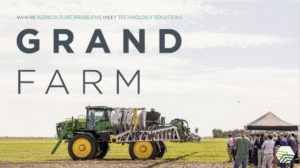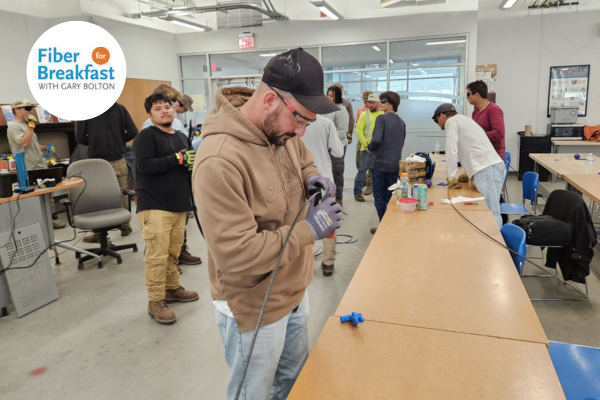FFB Week 40: The Future of Agriculture Grows on Fiber
The Future of Agriculture Grows on Fiber
This week’s Fiber for Breakfast podcast, Dr. William Aderholdt, Executive Director and Cofounder of Grand Farm discussed how fiber is accelerating innovation in agriculture and how Grand Farm supports real-world testing and validation of technologies like autonomous equipment, IoT sensors, and AI-driven tools that rely on strong broadband infrastructure.
In 2019, leaders in Fargo, North Dakota, posed a simple but far-reaching question: If our community had to choose a major, what would it be? The answer was clear—agriculture technology. That decision gave rise to Grand Farm, a collaborative network designed to accelerate innovation in farming by serving as a global testbed.
 “Grand Farm started by asking how we could take the problems and opportunities in agriculture and expose them to innovators from around the world,” said Aderholdt. “We wanted to bring people together on a testbed to accelerate innovation. Connectivity—last mile and last acre—was one of the first things we became known for talking about.”
“Grand Farm started by asking how we could take the problems and opportunities in agriculture and expose them to innovators from around the world,” said Aderholdt. “We wanted to bring people together on a testbed to accelerate innovation. Connectivity—last mile and last acre—was one of the first things we became known for talking about.”
The timing was significant. In 2019, federal investments in broadband were ramping up, and conversations around artificial intelligence and automation in rural communities were intensifying. Agriculture, historically one of the last industries to embrace digital transformation, suddenly had new opportunities—if connectivity could keep pace.
Building a Collaborative Ecosystem
Grand Farm today works with about 2,500 organizations worldwide, including 500 startups and 75 core partners ranging from universities like North Dakota State and the University of Georgia to major technology players like Microsoft. Local providers, such as Dakota Carrier Network, have been instrumental in enabling the connectivity required for innovation.
At the heart of Grand Farm’s model is collaboration. “A lot of technology is inevitable,” Adherholdt notes. “What is not inevitable is people coming together to talk about how it should move forward and who should be involved in that conversation.”
Every year, Grand Farm engages with growers, startups, corporations, government, and investors to identify emerging challenges and opportunities. These insights are created into reports which highlighted 65 major agricultural trends based on input from 25,000 growers. These findings are then shared globally, attracting innovators from Japan to the U.S. coasts to work alongside Midwestern farmers.
Broadband as the Foundation
Underlying all of this is connectivity. From drones and soil sensors to robotics and farm management platforms, modern agriculture depends on reliable, high-capacity fiber networks.
“You can’t design new tools if you don’t believe connectivity is going to be there,” Aderholdt emphasizes. “Forward-thinking investment in broadband infrastructure at the last mile has set the foundation for U.S. agriculture to reap the benefits of this technology. Connectivity had to be ahead of the change, ahead of the technology.”
The challenge now is extending that connectivity across entire farms—from the edge of the field to every acre. Fiber serves as the backbone, but supplemental technologies including wireless solutions help deliver data across vast, variable terrain.
Innovation in Practice
Grand Farm operates a 600-acre innovation campus where startups and researchers can test technologies without the usual barriers of access to land, equipment, or connectivity. This “relational testbed” pairs innovators with growers, investors, and policymakers, creating an environment where new ideas can move more quickly from prototype to adoption.
One example is a project with the USDA Agricultural Research Service in Nebraska, testing SoilTech sensors that transmit real-time soil data directly from potato fields. Traditionally, soil sampling took weeks to deliver results. Now, researchers and growers can make immediate decisions about irrigation, fertilizer, and crop health.
“It’s about instantaneous intelligence,” Dr. Aderholdt explains. “Farmers can’t wait two weeks for data to make a business decision.”
Addressing the Pain Points
Grand Farm’s annual grower engagement identifies pressing challenges where technology—and connectivity—play a central role. Current top issues include:
- Pest management: Herbicide-resistant weeds and invasive species require advanced detection and robotics supported by broadband-enabled data collection.
- Animal health: Connectivity aids in identifying and mitigating threats like screw worm infestations.
- AI context: Developing farm-specific AI models that don’t require retraining for every location remains a hurdle, one closely tied to the quality of rural GIS data and broadband access.
Economic and Community Impact
With $10 million in state funding matched by $5.3 million from private industry, Grand Farm has already produced measurable results. Twenty companies have relocated to North Dakota, nearly 100 new jobs have been created, and federal investments linked to its work exceed $300 million.
But leaders stress that the broader impact goes beyond metrics. “A lot of what we do has intangible value,” Aderholdt explained. “It’s hard to measure a startup raising $25 million and say we directly caused it. But through 80 engagements, through creating connections, we’ve accelerated that journey.”
The Telecom Takeaway
For telecommunications providers, Grand Farm underscores why fiber broadband matters far beyond streaming or remote work. In agriculture, connectivity is the bridge between emerging technology and real-world adoption. It enables artificial intelligence, precision agriculture, automation, and data-driven sustainability.
As Dr. Aderholdt noted, “Connectivity had to come first. Without it, none of this innovation would be possible.”
Click here to listen to the full episode or find previous episodes of Fiber for Breakfast.
Click here to view the slides used in this episode.



